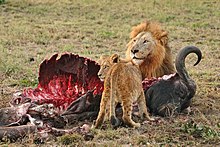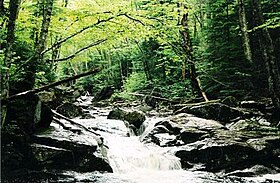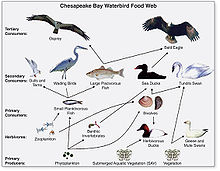Individual ecology
Understanding traits of individual organisms helps explain patterns and processes at other levels of organization including populations, communities, and ecosystems. Several areas of ecology of evolution that focus on such traits are life history theory, ecophysiology, metabolic theory of ecology, and Ethology. Examples of such traits include features of an organisms life cycle such as age to maturity, life span, or metabolic costs of reproduction. Other traits may be related to structure, such as the spines of a cactus or dorsal spines of a bluegill sunfish, or behaviors such as courtship displays or pair bonding. Other traits include emergent properties that are the result at least in part of interactions with the surrounding environment such as growth rate, resource uptake rate, winter, and deciduous vs. drought deciduous trees and shrubs.
One set of characteristics relate to body size and temperature. The metabolic theory of ecology provides a predictive qualitative set of relationships between an organism’s body size and temperature and metabolic processes. In general, smaller, warmer organisms have higher metabolic rates and this results in a variety of predictions regarding individual somatic growth rates, reproduction and population growth rates, population size, and resource uptake rates.
The traits of organisms are subject to change through acclimation, development, and evolution. For this reason, individuals form a shared focus for ecology and for evolutionary ecology.
Population ecology
Population ecology studies the dynamics of species populations and how these populations interact with the wider environment. A population consists of individuals of the same species that live, interact, and migrate through the same niche and habitat.
A primary law of population ecology is the Malthusian growth model which states, "a population will grow (or decline) exponentially as long as the environment experienced by all individuals in the population remains constant." Simplified population models usually start with four variables: death, birth, immigration, and emigration.
An example of an introductory population model describes a closed population, such as on an island, where immigration and emigration does not take place. Hypotheses are evaluated with reference to a null hypothesis which states that random processes create the observed data. In these island models, the rate of population change is described by:
where N is the total number of individuals in the population, b and d are the per capita rates of birth and death respectively, and r is the per capita rate of population change.
Using these modelling techniques, Malthus' population principle of growth was later transformed into a model known as the logistic equation:
where N is the number of individuals measured as biomass density, a is the maximum per-capita rate of change, and K is the carrying capacity of the population. The formula states that the rate of change in population size (dN/dT) is equal to growth (aN) that is limited by carrying capacity (1 – N/K).
Population ecology builds upon these introductory models to further understand demographic processes in real study populations. Commonly used types of data include life history, fecundity, and survivorship, and these are analysed using mathematical techniques such as matrix algebra. The information is used for managing wildlife stocks and setting harvest quotas. In cases where basic models are insufficient, ecologists may adopt different kinds of statistical methods, such as the Akaike information criterion,or use models that can become mathematically complex as "several competing hypotheses are simultaneously confronted with the data."
Metapopulations and migration
The concept of metapopulations was defined in 1969 as "a population of populations which go extinct locally and recolonize". Metapopulation ecology is another statistical approach that is often used in conservation research. Metapopulation models simplify the landscape into patches of varying levels of quality, and metapopulations are linked by the migratory behaviours of organisms. Animal migration is set apart from other kinds of movement; because, it involves the seasonal departure and return of individuals from a habitat. Migration is also a population-level phenomenon, as with the migration routes followed by plants as they occupied northern post-glacial environments. Plant ecologists use pollen records that accumulate and stratify in wetlands to reconstruct the timing of plant migration and dispersal relative to historic and contemporary climates. These migration routes involved an expansion of the range as plant populations expanded from one area to another. There is a larger taxonomy of movement, such as commuting, foraging, territorial behaviour, stasis, and ranging. Dispersal is usually distinguished from migration; because, it involves the one way permanent movement of individuals from their birth population into another population.
In metapopulation terminology, migrating individuals are classed as emigrants (when they leave a region) or immigrants (when they enter a region), and sites are classed either as sources or sinks. A site is a generic term that refers to places where ecologists sample populations, such as ponds or defined sampling areas in a forest. Source patches are productive sites that generate a seasonal supply of juveniles that migrate to other patch locations. Sink patches are unproductive sites that only receive migrants; the population at the site will disappear unless rescued by an adjacent source patch or environmental conditions become more favourable. Metapopulation models examine patch dynamics over time to answer potential questions about spatial and demographic ecology. The ecology of metapopulations is a dynamic process of extinction and colonization. Small patches of lower quality (i.e., sinks) are maintained or rescued by a seasonal influx of new immigrants. A dynamic metapopulation structure evolves from year to year, where some patches are sinks in dry years and are sources when conditions are more favourable. Ecologists use a mixture of computer models and field studies to explain metapopulation structure.
Community ecology
Community ecology examines how interactions among species and their environment affect the abundance, distribution and diversity of species within communities.
Community ecology is the study of the interactions among a collections of species that inhabit the same geographic area. Community ecologists study the determinants of patterns and processes for two or more interacting species. Research in community ecology might measure species diversity in grasslands in relation to soil fertility. It might also include the analysis of predator-prey dynamics, competition among similar plant species, or mutualistic interactions between crabs and corals.
Ecosystem ecology
These ecosystems, as we may call them, are of the most various kinds and sizes. They form one category of the multitudinous physical systems of the universe, which range from the universe as a whole down to the atom.
Ecosystems may be habitats within biomes that form an integrated whole and a dynamically responsive system having both physical and biological complexes. Ecosystem ecology is the science of determining the fluxes of materials (e.g. carbon, phosphorus) between different pools (e.g., tree biomass, soil organic material). Ecosystem ecologist attempt to determine the underlying causes of these fluxes. Research in ecosystem ecology might measure primary production (g C/m^2) in a wetland in relation to decomposition and consumption rates (g C/m^2/y). This requires an understanding of the community connections between plants (i.e., primary producers) and the decomposers (e.g., fungi and bacteria),
The underlying concept of ecosystem can be traced back to 1864 in the published work of George Perkins Marsh ("Man and Nature"). Within an ecosystem, organisms are linked to the physical and biological components of their environment to which they are adapted. Ecosystems are complex adaptive systems where the interaction of life processes form self-organizing patterns across different scales of time and space. Ecosystems are broadly categorized as terrestrial, freshwater, atmospheric, or marine. Differences stem from the nature of the unique physical environments that shapes the biodiversity within each. A more recent addition to ecosystem ecology are technoecosystems, which are affected by or primarily the result of human activity.
Food webs
A food web is the archetypal ecological network. Plants capture solar energy and use it to synthesize simple sugars during photosynthesis. As plants grow, they accumulate nutrients and are eaten by grazing herbivores, and the energy is transferred through a chain of organisms by consumption. The simplified linear feeding pathways that move from a basal trophic species to a top consumer is called the food chain. The larger interlocking pattern of food chains in an ecological community creates a complex food web. Food webs are a type of concept map or a heuristic device that is used to illustrate and study pathways of energy and material flows.
Food webs are often limited relative to the real world. Complete empirical measurements are generally restricted to a specific habitat, such as a cave or a pond, and principles gleaned from food web microcosm studies are extrapolated to larger systems. Feeding relations require extensive investigations into the gut contents of organisms, which can be difficult to decipher, or stable isotopes can be used to trace the flow of nutrient diets and energy through a food web. Despite these limitations, food webs remain a valuable tool in understanding community ecosystems.
Food webs exhibit principles of ecological emergence through the nature of trophic relationships: some species have many weak feeding links (e.g., omnivores) while some are more specialized with fewer stronger feeding links (e.g., primary predators). Theoretical and empirical studies identify non-random emergent patterns of few strong and many weak linkages that explain how ecological communities remain stable over time. Food webs are composed of subgroups where members in a community are linked by strong interactions, and the weak interactions occur between these subgroups. This increases food web stability. Step by step lines or relations are drawn until a web of life is illustrated.
Trophic levels
A trophic level (from Greek troph, τροφή, trophē, meaning "food" or "feeding") is "a group of organisms acquiring a considerable majority of its energy from the adjacent level nearer the abiotic source." Links in food webs primarily connect feeding relations or trophism among species. Biodiversity within ecosystems can be organized into trophic pyramids, in which the vertical dimension represents feeding relations that become further removed from the base of the food chain up toward top predators, and the horizontal dimension represents the abundance or biomass at each level.When the relative abundance or biomass of each species is sorted into its respective trophic level, they naturally sort into a 'pyramid of numbers'.
Species are broadly categorized as autotrophs (or primary producers), heterotrophs (or consumers), and Detritivores (or decomposers). Autotrophs are organisms that produce their own food (production is greater than respiration) by photosynthesis or chemosynthesis. Heterotrophs are organisms that must feed on others for nourishment and energy (respiration exceeds production). Heterotrophs can be further sub-divided into different functional groups, including primary consumers (strict herbivores), secondary consumers (carnivorous predators that feed exclusively on herbivores), and tertiary consumers (predators that feed on a mix of herbivores and predators). Omnivores do not fit neatly into a functional category because they eat both plant and animal tissues. It has been suggested that omnivores have a greater functional influence as predators, because compared to herbivores, they are relatively inefficient at grazing.
Trophic levels are part of the holistic or complex systems view of ecosystems. Each trophic level contains unrelated species that are grouped together because they share common ecological functions, giving a macroscopic view of the system. While the notion of trophic levels provides insight into energy flow and top-down control within food webs, it is troubled by the prevalence of omnivory in real ecosystems. This has led some ecologists to "reiterate that the notion that species clearly aggregate into discrete, homogeneous trophic levels is fiction." Nonetheless, recent studies have shown that real trophic levels do exist, but "above the herbivore trophic level, food webs are better characterized as a tangled web of omnivores."
Keystone species
A keystone species is a species that is connected to a disproportionately large number of other species in the food-web. Keystone species have lower levels of biomass in the trophic pyramid relative to the importance of their role. The many connections that a keystone species holds means that it maintains the organization and structure of entire communities. The loss of a keystone species results in a range of dramatic cascading effects that alters trophic dynamics, other food web connections, and can cause the extinction of other species.
Sea otters (Enhydra lutris) are commonly cited as an example of a keystone species; because, they limit the density of sea urchins that feed on kelp. If sea otters are removed from the system, the urchins graze until the kelp beds disappear, and this has a dramatic effect on community structure. Hunting of sea otters, for example, is thought to have led indirectly to the extinction of the Steller's sea cow (Hydrodamalis gigas). While the keystone species concept has been used extensively as a conservation tool, it has been criticized for being poorly defined from an operational stance. It is difficult to experimentally determine what species may hold a keystone role in each ecosystem. Furthermore, food web theory suggests that keystone species may not be common, so it is unclear how generally the keystone species model can be applied







No comments:
Post a Comment